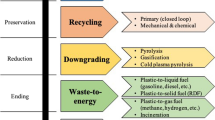Abstract
The generation of Scrap Lead-Acid Battery (LAB) in China has increased sharply in the recent decade and more than half of it comes from residents with automobiles and electric bicycles (E-bike). To investigate the behavior, awareness and willingness to pay (WTP), a sample of 1000 in Beijing was surveyed based on a questionnaire in June 2014. 70.95 % of residents will dispose LAB to maintainers or dealers and 17.22 % will dispose them to peddlers. 37.49 % of residents do not know that scrap LAB is hazardous. 38.22 % of residents who accept to pay prefer to pay by “trade old for new one”, which is the most convenient way. 0–1 style logistic regression was used and found that only EPR knowledge and part household income have a relationship with WTP. contingent value method (CVM) was used and found that residents with automobiles accept 48.72 CNY/battery or 4.96 % of battery, whereas residents with E-bikes accept 26.05 CNY/battery or 4.04 %. 73.45 % of local residents make it clear that they want to pay to outside recycle plants which treat most of the scrap LAB from Beijing. These results can help authorities develop the fund impose method and value for scrap LAB from the resident view.






Similar content being viewed by others
References
Guo Y (2013) Initial formation pattern of Lead-acid battery industry. China Ind 2:263–266
Shang HL (2014) Chinese secondary lead industry future prospects. China Nonferrous Metals 4:158–162
Zhang LF (2013) Domestic electric bicycle ownership will break the 200 million. Econ Inf Dly 10:213–217
Wang JL, Meng LR, Hu XG (2011) Situation and development trend of China’s lead-acid battery industry. China Battery Industry 02:111–116
Han B (2013) The new national bike standard lead industry transformation. China Int Bus 10:131–136
Prengaman R (2000). Lead product development in the millennium. Proc of the Lead-Zinc 2000 Symp
Chen HY, Li AJ, Finlow DE (2009) The lead and lead-acid battery industries during 2002 and 2007 in China. J Power Sources 1:22–27
Van den Bossche P, Vergels F, Van Mierlo J (2006) SUBAT: an assessment of sustainable battery technology. J Power Sources 2:913–919
Wei ZC (2012). Beijing Urban mineral industry development model and effectiveness evaluation studies. Beijing University of Technology, Beijing
Li J, Yu K, Gao P (2014) Recycling and pollution control of the End of Life Vehicles in China. J Mater Cycles Waste 1:31–38
CNMA (2014) China nonferrous metals industry yearbook. China Industry Press, Beijing
Raghupathy L, Chaturvedi A (2013) Secondary resources and recycling in developing economies. Sci Total Environ 461:830–834
Lu C, Zhang L, Zhong Y (2014) An overview of e-waste management in China. J Mater Cycles Waste 17:1–12
Foucault Y, Durand M, Tack K (2013) Use of ecotoxicity test and ecoscores to improve the management of polluted soils: Case of a secondary lead smelter plant. J Hazard Mater 246:291–299
Yi M (2009) lead pollution discussion from fengxiang child lead poisoning. China Environ Education 09:55–56
Mao JS, Cao J, Graedel TE (2009) Losses to the environment from the multilevel cycle of anthropogenic lead. Environ Pollut 10:2670–2677
Chen L, Xu Z, Liu M (2012) Lead exposure assessment from study near a lead-acid battery factory in China. Sci Total Environ 191–198
Pariatamby A, Victor D (2013) Policy trends of e-waste management in Asia. J Mater Cycles Waste 4:411–419
Sakai S, Yoshida H, Hirai Y (2011) International comparative study of 3R and waste management policy developments. J Mater Cycles Waste 2:86–102
Tian X, Gong Y, Wu Y (2014) Management of used lead acid battery in China: Secondary lead industry progress, policies and problems. Resour Conserv Recycl 75–84
Cherry CR, Weinert JX, Xinmiao Y (2009) Comparative environmental impacts of electric bikes in China. Transport Res Part D Transport Environ 5:281–290
Weinert J, Ogden J, Sperling D (2008) The future of electric two-wheelers and electric vehicles in China. Energ Policy 7:2544–2555
Yang X (2014). Chinese scrap lead-acid battery recycling problems and countermeasures. Secondary battery recycling technology seminar, Beijing
Andreas P (2013) A comparative overview of large-scale battery systems for electricity storage. Renew Sustain Energy Rev 27:778–788
Soloveichik GL (2011) Battery technologies for large-scale stationary energy storage. Annu Rev Chem Biomol 7:503–527
Ami D, Aprahamian F, Chanel O (2014) Willingness to pay of committed citizens: A field experiment. ECOL ECON 0:31–39
Wang Z, Zhang B, Yin J (2011) Willingness and behavior towards e-waste recycling for residents in Beijing city, China. J Clean Prod 9–10:977–984
Arrow K, Solow R (1993) Report of NOAA panel on contingent valuation. Federal Register 10:4602–4614
Zhan S, Zhang H (2012) Awareness and willingness to pay for municipal waste separation and recovery. Urban Problem 04:57–62
Song Q, Wang Z, Li J (2012) Residents’ behaviors, attitudes, and willingness to pay for recycling e-waste in Macau. J Environ Manage 0:8–16
Keramitsoglou KM, Tsagarakis KP (2013) Public participation in designing a recycling scheme towards maximum public acceptance. Resources, Conservation and Recycling 0:55–67
Shang HL (2008) Evaluation of Chinese secondary lead industry. China Renew Resour 08:19–21
Ding L (2012) Should the surgical of secondary lead industry success? China Non-ferrous Metal 10:134–139
Olper IM, Asano B (1989) Improved technology in secondary lead processing—ENGITEC lead acid battery recycling system. Pergamon, Amsterdam
Acknowledgments
The authors gratefully acknowledge the financial support from the National High Technology Research and Development Program of China (Grant No. 2012AA063207), Interdisciplinary Beijing Municipal Key Discipline, “Resources, Environment and Recycling Economy” Project (033000541214001).
Author information
Authors and Affiliations
Corresponding author
Electronic supplementary material
Below is the link to the electronic supplementary material.
Rights and permissions
About this article
Cite this article
Tian, X., Wu, Y., Gong, Y. et al. Residents’ behavior, awareness, and willingness to pay for recycling scrap lead-acid battery in Beijing. J Mater Cycles Waste Manag 17, 655–664 (2015). https://doi.org/10.1007/s10163-015-0430-7
Received:
Accepted:
Published:
Issue Date:
DOI: https://doi.org/10.1007/s10163-015-0430-7




